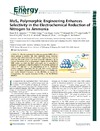Please use this identifier to cite or link to this item:
https://accedacris.ulpgc.es/handle/10553/74731
| DC Field | Value | Language |
|---|---|---|
| dc.contributor.author | Suryanto, Bryan H. R. | en_US |
| dc.contributor.author | Wang, Dabin | en_US |
| dc.contributor.author | Azofra Mesa, Luis Miguel | en_US |
| dc.contributor.author | Harb, Moussab | en_US |
| dc.contributor.author | Cavallo, Luigi | en_US |
| dc.contributor.author | Jalili, Rouhollah | en_US |
| dc.contributor.author | Mitchell, David R. G. | en_US |
| dc.contributor.author | Chatti, Manjunath | en_US |
| dc.contributor.author | MacFarlane, Douglas R. | en_US |
| dc.date.accessioned | 2020-10-14T11:27:21Z | - |
| dc.date.available | 2020-10-14T11:27:21Z | - |
| dc.date.issued | 2019 | en_US |
| dc.identifier.issn | 2380-8195 | en_US |
| dc.identifier.uri | https://accedacris.ulpgc.es/handle/10553/74731 | - |
| dc.description.abstract | The electrochemical N2 reduction reaction (NRR) offers a direct pathway to produce NH3 from renewable energy. However, aqueous NRR suffers from both low Faradaic efficiency (FE) and low yield rate. The main reason is the more favored H+ reduction to H2 in aqueous electrolytes. Here we demonstrate a highly selective Ru/MoS2 NRR catalyst on which the MoS2 polymorphs can be controlled to suppress H+ reduction. A NRR FE as high as 17.6% and NH3 yield rate of 1.14 × 10−10 mol cm−2 s −1 are demonstrated at 50 °C. Theoretical evidence supports a hypothesis that the high NRR activity originates from the synergistic interplay between the Ru clusters as N2 binding sites and nearby isolated S-vacancies on the 2H-MoS2 as centers for hydrogenation; this supports formation of NH3 at the Ru/2H-MoS2 interface. | en_US |
| dc.language | eng | en_US |
| dc.relation.ispartof | ACS Energy Letters | en_US |
| dc.source | ACS Energy Letters [ISSN 2380-8195], v. 4, p. 430-435 | en_US |
| dc.subject | 221001 Catálisis | en_US |
| dc.title | MoS2 Polymorphic Engineering Enhances Selectivity in the Electrochemical Reduction of Nitrogen to Ammonia | en_US |
| dc.type | info:eu-repo/semantics/article | en_US |
| dc.type | Article | en_US |
| dc.identifier.doi | 10.1021/acsenergylett.8b02257 | en_US |
| dc.description.lastpage | 435 | en_US |
| dc.identifier.issue | 2 | - |
| dc.description.firstpage | 430 | en_US |
| dc.relation.volume | 4 | en_US |
| dc.investigacion | Ciencias | en_US |
| dc.type2 | Artículo | en_US |
| dc.description.observaciones | No ULPGC | en_US |
| dc.description.numberofpages | 6 | en_US |
| dc.utils.revision | Sí | en_US |
| dc.identifier.ulpgc | No | en_US |
| dc.description.sjr | 8,057 | |
| dc.description.jcr | 19,003 | |
| dc.description.sjrq | Q1 | |
| dc.description.jcrq | Q1 | |
| dc.description.scie | SCIE | |
| item.fulltext | Con texto completo | - |
| item.grantfulltext | open | - |
| crisitem.author.dept | GIR IUNAT: Fotocatálisis y espectroscopía para aplicaciones medioambientales. | - |
| crisitem.author.dept | IU de Estudios Ambientales y Recursos Naturales | - |
| crisitem.author.orcid | 0000-0003-4974-1670 | - |
| crisitem.author.parentorg | IU de Estudios Ambientales y Recursos Naturales | - |
| crisitem.author.fullName | Azofra Mesa, Luis Miguel | - |
| Appears in Collections: | Artículos | |
WEB OF SCIENCETM
Citations
278
checked on Jun 8, 2025
Page view(s)
93
checked on May 4, 2024
Download(s)
641
checked on May 4, 2024
Google ScholarTM
Check
Altmetric
Share
Export metadata
Items in accedaCRIS are protected by copyright, with all rights reserved, unless otherwise indicated.
